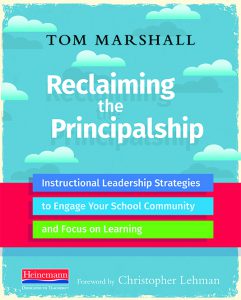
The following is adapted from Reclaiming the Principalship by Tom Marshall.
A fine line is drawn when the principal, who is the primary evaluator of classroom practice, acts as the coach. Coaches work with teachers when teachers are most vulnerable: teaching often less-than-polished lessons; working toward new competencies, but not yet mastering them. If we want teachers to take risks and grow, we must learn to notice things with a different lens—a coaching lens.
This is tricky work. You never really can separate yourself, leaving the evaluative part outside when you enter the classroom. Just the same, you never really abandon the coaching part of you when you enter a classroom, either. Part of instructional leadership is knowing when to let each part of you take the lead.
Let’s say you walk into a classroom and see something that should be addressed. Maybe the students are not engaged in their work. You might notice that the charts on the wall are disorganized or all store-bought. There could be something in the physical arrangement of the room that needs to be fixed. How do you react? You might choose to let the supervisor in you react, telling the teacher what to change, implicitly or explicitly relying on your authority as principal to ensure that the change is made. Or, you might choose to let the coach in you react, treating the issue as a teachable moment.
|
DESCRIPTIONS OF SUPERVISOR/ADMINISTRATIVE RESPONSES VERSUS DESCRIPTIONS OF COACHING RESPONSES |
|
|
Supervisor/Administrative Responses |
Coaching Responses |
|
|
Let’s examine these two different approaches in response to the same situation: You notice that all the anchor charts in Amy’s classroom are in disarray on the walls. There seems to be no rhyme or reason to their organization. Science, writing, and math charts are lumped together. In fact, you notice that there are too many charts up on the wall, from all parts of the year, including charts that cover content that has already been mastered.
|
EXAMPLES OF ADMINISTRATIVE RESPONSES VERSUS EXAMPLES OF COACHING RESPONSES |
|
|
Administrative Response |
Coaching Response |
|
You very directly approach Amy and tell her that her charts are disorganized and that she should clean them up. You tell her that kids are probably feeling overwhelmed by all the information on the walls and that it’s not as effective as if charts were organized according to subject area, and limited to what is being learned currently. You follow this up with a memo and tell her she has until Friday to make this right.
POSSIBLE OUTCOME: The teacher might make the changes you noted, and might even make them relatively quickly, but these changes won’t have much sticking power. The teacher will comply with your wishes, but won’t be engaged with what you were trying to achieve, so she will make the same mistakes again, possibly even hiding concerns from you in the future. |
You make not of the arrangement of the charts on the wall, and you casually mention it to Amy. During subsequent visits, you coach Amy on just how students interact with charts to make them more independent in their work. In your coaching time, you layer in opportunities for Amy to see students acting with success when the charts are organized and relevant to current learning. You follow up with conversation and create a new common expectation.
POSSIBLE OUTCOME: The teacher will live with the idea for a sustained period of time, and the scaffolding, conversation, and exchange of ideas will engage the teacher in a deep thought process, at the end of which she will learn a lesson about teaching and learning that will spill over into other parts of her practice. This takes much longer, but its effects last much longer, too. |
Of course, there are times when an administrative response is necessary. A safety issue (blocking a fire egress, bad classroom management that becomes dangerous, the evolution of a disrespectful learning environment) needs to be handled with administrative response. When a teacher resists improvement even after something has been coached and explored and reinforced, administrative response is required. These are instances when compliance is necessary. But when we employ the administrative response too quickly, we achieve only short-term compliance. The teacher might do as she was told quickly out of fear of repercussion, without really understanding why the practice was not the best one. In fact, the only lesson she might learn is to hide her practices from you. Not long-term, systemic change in teacher practice happens when we do this.
When we employ the coaching response, we have to allow the teacher time to explore and question the practice and allow ourselves time to work with the teacher on this practice. Making changes with coaching can take longer than simply issuing an administrative order. However, coaching, when done well, will have long-lasting effects.
When I see a less than desirable practice in the classroom and I’m considering which course to take—administrative or coaching—I ask myself the following questions:
-
Why is the teacher doing this? Is it lack of knowledge, misinformed or dated practice, ignorance of what has been studied as a school community?
-
Has the teacher been provided ample opportunities to know how alternatives might work?
-
Is the practice hindering student success? Is the practice getting in the way of the mission of the school or grade level?
-
Is the practice dangerous? Is it an obstruction to student safety?
-
Can this wait or do we need immediate compliance? Is the practice something that can be sustained through mere compliance, or is a deeper understanding necessary for the practice to be maintained in the long run?

To learn more about Reclaiming the Principalship, visit Heinemann.com.
 Tom Marshall is a former teacher and staff developer at the Teachers College Reading and Writing Project. He is currently the principal of Stony Lane Elementary School in Paramus, New Jersey.
Tom Marshall is a former teacher and staff developer at the Teachers College Reading and Writing Project. He is currently the principal of Stony Lane Elementary School in Paramus, New Jersey.
Tom runs a course for literacy coaches from around New Jersey, coordinates the Littogether Teacher Leader Project, and is the founder of the New Jersey Literacy Leaders' Network, a learning group of over 150 educational leaders who meet to study ways to supervise and support best practices in literacy instruction. You can find him online at http://www.littogether.com and on twitter at @TomLitTogether.


